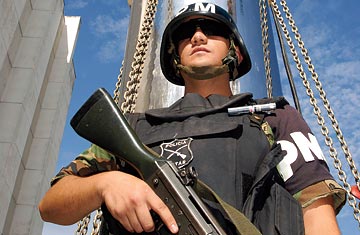
A Chilean police officer guards a cask containing Hightly Enriched uranium at the La Reina nuclear reactor in Santiago, Chile.
Andrew Bieniawski was in bed when the earthquake struck. On Feb. 26, Bieniawski, the assistant deputy administrator for the U.S. National Nuclear Security Administration (NNSA), had arrived in Santiago, Chile, to join a group of scientists and nuclear engineers on a top-secret mission to remove a potential nuclear bomb from the country. Around 40 lb. (18 kg) of highly enriched uranium (HEU)--with enough latent energy to destroy a portion of a city--had already been inventoried, secured and made ready for transport to a highly secure facility in the U.S. Running ahead of schedule, Bieniawski had taken his team out for dinner with the U.S. ambassador before heading to bed. Then the big one hit.
The Chilean earthquake carried the power of 10,000 Hiroshima bombs. It severed power and communication lines, closed highways, sparked looting and led the country's President to declare a state of emergency. Within minutes of the quake, Bieniawski had gathered the NNSA officials in a hotel lobby, where the group spent the next four hours trying to make contact with two sites--a military base and research reactor--where the uranium had been stored. Unable to reach one of the sites by phone, the head of the Chilean nuclear agency, Fernando López-Lizana, eventually had to drive there himself.
After López-Lizana reported that the uranium was accounted for, the NNSA team had to shift it through a crisis zone to a port on high alert for tsunamis. And their cargo was unstable. HEU must be stored and shipped in certain geometrical configurations--long, flat sheets, for instance--so that it does not spontaneously start a nuclear chain reaction, spewing out heat and radioactive by-products. When it has been used in a nuclear reactor, as some of the Chilean HEU had been, it becomes radioactive. Twelve hours before the earthquake, the NNSA engineers had overseen the fitting of 1,500-lb. (680 kg) protective impact limiters on the material, designed to shield it from the force of an explosion--or, indeed, an earthquake--and placed an airtight cask around the irradiated uranium. They felt confident the packages would not jostle around and suddenly go critical or leak. But how to get them out of a country in chaos?
For the following four days, Bieniawski and his team plus a U.S. shipping contractor met with Chilean officials to plan an escape route. The meetings had an odd quality--aftershocks twice spilled coffee from cups. The original plan was to ship the HEU to the U.S. from the Chilean port of San Antonio, but it had been destroyed by a tsunami, so eventually the team decided to use the port of Valparaíso, 50 miles (80 km) to the north. On the evening of March 2, the officials and security teams met at the Lo Aguirre military base about 25 miles (40 km) from Santiago, which contained a military reactor built in 1977 for unspecified "defense purposes." The power was out, and moments before the convoy pulled out, the earth shook with yet another strong aftershock, with its epicenter at Valparaíso. As the convoy left, Bieniawski took out his phone, called up the sound track for the Pirates of the Caribbean movie--his favorite "pump up" track--and hit play. "It's time to raise our game, fellas," he said.
Uranium for Free
